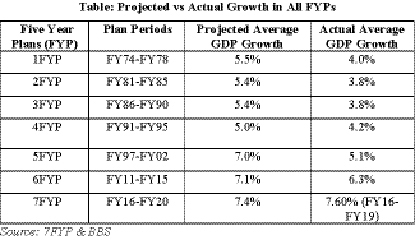It is now official that Bangladesh economy is set to post 8-plus growth. Finance Minister AHM Mustafa Kamal has already announced this on the basis of preliminary estimation of the current fiscal year's (FY19) Gross Domestic Product (GDP). Bangladesh Bureau of Statistics (BBS), the national statistical agency, has estimated GDP in the current fiscal year is likely to post 8.13 per cent growth over the past fiscal year. This would be for the first time that the country's economy registered 8-plus growth rate indicating further expansion of overall economic activities.
The 8-plus growth in the current fiscal year also pushed the annual average growth rate during the last 10 years at 6.75 per cent. In fact, it was in FY16, when GDP growth rate breached the '6.0 per cent cycle' for the first time and crossed 7.0 per cent threshold. It took at least five years to come out from the '6.0 per cent cycle' and this is not unusual as consistent expansion of economy needs time and political stability. Interestingly, it has taken only three years to post 8-plus growth from 7-plus growth cycle indicating rapid rise in growth rate.

The 8.13 per cent growth in FY19 is also much higher than the projected 7.60 per cent growth rate in the Seventh Five-Year Plan (7FYP). From the beginning of the plan period (FY16), GDP growth rate has been going beyond the projected rate each year which did not happen during the 6FYP. The average actual GDP growth during the 6FYP period was 6.30 per cent against the average projected rate of 7.30 per cent. In fact, never-ever in the history of Bangladesh, economic growth rate matched the projected or targeted rates in different five-year plans, from first FYP to sixth FYP. In this regard, the current trend of growth rate is quite encouraging despite questions on the quality of growth.
While higher growth is necessary, it also needs to be distributed as evenly as possible to make the benefit of growth widespread. This is a critical area where policymakers are yet to focus adequately.
Growth rate of GDP or even GDP itself is basically a gross count of products and services exchanged in monetary terms. It doesn't consider whether transactions add to well-being or otherwise. GDP assumes that every financial transaction ultimately results in some form of well-being which is not true. Moreover, by theory, GDP overlooks what happens outside the territory of monetised exchange no matter how important those are for well-being. That's why, economic activities performed in the household are not recorded in GDP accounting.
So, it is now well-recognised that GDP is not a measure of the overall standard of living or well-being of a country. Although changes in the output of goods and services per person (GDP per capita) are often used as a measure of whether the average citizen in a country is better or worse off, it does not capture things that may be deemed important to general well-being.' (Gross Domestic Product: An Economy's All; F&D, IMF, 2018)
Nevertheless, GDP is important and can't be ignored at all. Same thing is true for GDP growth which measures the change in the size of the economy over time. The higher the growth rate, the faster the expansion of economic activities in a country. The emphasis on growth is based on the assumption that it will create more resource and more people will be able to access the resource through market mechanism with limited intervention from the state. Having over 160 million people in a small territory (147,570sq KM), there is no alternative to higher and rapid growth to create jobs. So, higher growth needs to match with employment situation also. Some 6.70 million new jobs were created during 2010 and 2017 which means 0.67 million jobs were created annually on average during the period. This is not a very bright scenario, especially when the economy has entered into higher trajectory of GDP growth. As the BBS is yet to update labour force survey, number of real jobs in FY18 and FY19 is not known.
Notwithstanding the limitations of GDP growth, the 8-plus growth in the current fiscal year would be a matter of celebration no doubt. But one needs to be cautious before celebrating the achievement.
Even before completion of the third quarter of the fiscal year, estimating the annual growth rate appears a bit puzzling. It means that BBS has to take maximum seven months data of different sectors' outputs. For instance, the statistical agency, so far, released five months (July-November) data of quantum index of medium and large-scale manufacturing industrial output. It is not clear how the BBS surmised full year's provisional industrial output on the basis of less than half-year's data. Of course, eight months export and seven months import data are there to provide more information on industrial sector. Some other indicators are also there to gauge the industrial output. But it is the period of time that is critical to substantiate the preliminary estimate of industrial output which registerd 13 per cent growth in the current fiscal year.
Another area is agricultural output which is estimated to grow by 3.51 per cent in the current fiscal year but the rate was 4.19 per cent in the past fiscal year. It means farm output growth is to decline in the current fiscal year. Without having the estimate of Boro output in hand, it is mostly a speculative work to estimate the farm sector growth as Boro is a major component of the agriculture sector. Currently, Boro and Aman yields account for 55 per cent and 38 per cent of the total rice supply in the country respectively.
Preliminary estimate of growth is subject to revision. An accurate picture of growth will appear after six months from now when the BBS should be addressing the limitations of preliminary estimation.
© 2024 - All Rights with The Financial Express
